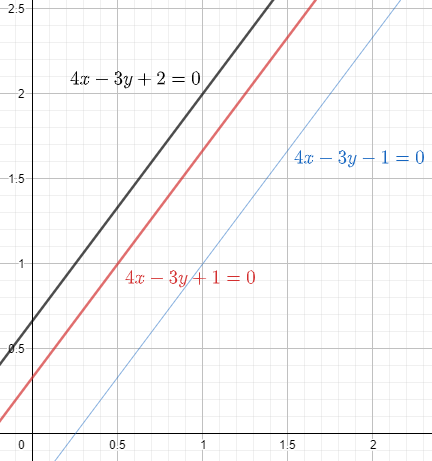
Lines are drawn parallel to the line 4x-3y+2 = 0 at a distance of $\dfrac{3}{5}$ from the origin. The which of the following points lies on any one of these lines?
[a] $\left( \dfrac{-1}{4},\dfrac{2}{3} \right)$
[b] $\left( \dfrac{1}{4},\dfrac{2}{3} \right)$
[c] $\left( -\dfrac{1}{4},-\dfrac{2}{3} \right)$
[d] $\left( \dfrac{1}{4},\dfrac{1}{3} \right)$
Answer
574.2k+ views
Hint: Use the fact that the slope of the line $Ax+By+C=0$ is given by $m=\dfrac{-A}{B}$. Hence find the slope of the line 4x-3y+2 = 0. Use the fact that the equation of a line parallel to another line of slope m is given by $y=mx+c$. Use the fact that the distance of a line from origin can be found by converting the equation of line to normal form i.e. $x\cos \alpha +y\sin \alpha =p,p\ge 0$. Hence find the equation of the lines parallel to the line 4x-3y+2 and at a distance of $\dfrac{3}{5}$ from the origin
Complete step by step answer:

Lines in blue and red are at a distance of $\dfrac{3}{5}$ from origin. The black line is the line 4x-3y+2 = 0
We know that the slope of the line $Ax+By+C=0$ is given by $m=\dfrac{-A}{B}$.
Hence, we have
The slope of the line 4x-3y+2 = 0 is $\dfrac{-4}{-3}=\dfrac{4}{3}$
We know that any line parallel to a line of slope of m is given by y = mx + c
We know that for converting the equation of the line $Ax+By=C$ into normal form, we divide both sides by $\sqrt{{{A}^{2}}+{{B}^{2}}}$
Hence, we have
Equation of a line parallel to the line 4x-3y+2 = 0 is $y=\dfrac{4x}{3}+c$
Dividing both sides by $\sqrt{1+\dfrac{{{4}^{2}}}{{{3}^{2}}}}$, we get
$\dfrac{y}{\sqrt{1+\dfrac{{{4}^{2}}}{{{3}^{2}}}}}-\dfrac{\dfrac{4}{3}x}{\sqrt{1+\dfrac{{{4}^{2}}}{{{3}^{2}}}}}=\dfrac{c}{\sqrt{1+\dfrac{{{4}^{2}}}{{{3}^{2}}}}}$ which is the equation of the line in normal form.
Hence the distance of the line from the origin is $\dfrac{\left| c \right|}{\sqrt{1+\dfrac{{{4}^{2}}}{{{3}^{2}}}}}=\dfrac{3\left| c \right|}{5}$
But given that the distance of the line from the origin is $\dfrac{3}{5}$
Hence, we have
$\begin{align}
& \dfrac{3\left| c \right|}{5}=\dfrac{3}{5} \\
& \Rightarrow c=\pm 1 \\
\end{align}$
Hence, the equation of the line is
$y=\dfrac{4}{3}x\pm 1$
When $x=\dfrac{-1}{4}$, we have
\[y=\dfrac{-1}{3}\pm 1=\dfrac{2}{3},\dfrac{-4}{3}\]
Hence the points $\left( \dfrac{-1}{4},\dfrac{2}{3} \right),\left( -\dfrac{1}{4},\dfrac{-4}{3} \right)$ lie on one of the two possible lines.
Similarly, when $x=\dfrac{1}{4}$, we have
$y=\dfrac{-2}{3},\dfrac{4}{3}$
Hence, the points $\left( \dfrac{1}{4},\dfrac{-2}{3} \right),\left( \dfrac{1}{4},\dfrac{4}{3} \right)$ lie on one of the two possible lines.
So, the correct answer is “Option A”.
Note: [1] In this question many students make mistakes in solving the equation involving modulus. It must be noted that the solution of the equation $\left| x \right|=a,a\ge 0$ is $x=\pm a$. If we take only x = a, then the solution x = -a is lost and hence we arrive at incorrect conclusion
Complete step by step answer:

Lines in blue and red are at a distance of $\dfrac{3}{5}$ from origin. The black line is the line 4x-3y+2 = 0
We know that the slope of the line $Ax+By+C=0$ is given by $m=\dfrac{-A}{B}$.
Hence, we have
The slope of the line 4x-3y+2 = 0 is $\dfrac{-4}{-3}=\dfrac{4}{3}$
We know that any line parallel to a line of slope of m is given by y = mx + c
We know that for converting the equation of the line $Ax+By=C$ into normal form, we divide both sides by $\sqrt{{{A}^{2}}+{{B}^{2}}}$
Hence, we have
Equation of a line parallel to the line 4x-3y+2 = 0 is $y=\dfrac{4x}{3}+c$
Dividing both sides by $\sqrt{1+\dfrac{{{4}^{2}}}{{{3}^{2}}}}$, we get
$\dfrac{y}{\sqrt{1+\dfrac{{{4}^{2}}}{{{3}^{2}}}}}-\dfrac{\dfrac{4}{3}x}{\sqrt{1+\dfrac{{{4}^{2}}}{{{3}^{2}}}}}=\dfrac{c}{\sqrt{1+\dfrac{{{4}^{2}}}{{{3}^{2}}}}}$ which is the equation of the line in normal form.
Hence the distance of the line from the origin is $\dfrac{\left| c \right|}{\sqrt{1+\dfrac{{{4}^{2}}}{{{3}^{2}}}}}=\dfrac{3\left| c \right|}{5}$
But given that the distance of the line from the origin is $\dfrac{3}{5}$
Hence, we have
$\begin{align}
& \dfrac{3\left| c \right|}{5}=\dfrac{3}{5} \\
& \Rightarrow c=\pm 1 \\
\end{align}$
Hence, the equation of the line is
$y=\dfrac{4}{3}x\pm 1$
When $x=\dfrac{-1}{4}$, we have
\[y=\dfrac{-1}{3}\pm 1=\dfrac{2}{3},\dfrac{-4}{3}\]
Hence the points $\left( \dfrac{-1}{4},\dfrac{2}{3} \right),\left( -\dfrac{1}{4},\dfrac{-4}{3} \right)$ lie on one of the two possible lines.
Similarly, when $x=\dfrac{1}{4}$, we have
$y=\dfrac{-2}{3},\dfrac{4}{3}$
Hence, the points $\left( \dfrac{1}{4},\dfrac{-2}{3} \right),\left( \dfrac{1}{4},\dfrac{4}{3} \right)$ lie on one of the two possible lines.
So, the correct answer is “Option A”.
Note: [1] In this question many students make mistakes in solving the equation involving modulus. It must be noted that the solution of the equation $\left| x \right|=a,a\ge 0$ is $x=\pm a$. If we take only x = a, then the solution x = -a is lost and hence we arrive at incorrect conclusion
Recently Updated Pages
Why are manures considered better than fertilizers class 11 biology CBSE

Find the coordinates of the midpoint of the line segment class 11 maths CBSE

Distinguish between static friction limiting friction class 11 physics CBSE

The Chairman of the constituent Assembly was A Jawaharlal class 11 social science CBSE

The first National Commission on Labour NCL submitted class 11 social science CBSE

Number of all subshell of n + l 7 is A 4 B 5 C 6 D class 11 chemistry CBSE

Trending doubts
What is meant by exothermic and endothermic reactions class 11 chemistry CBSE

10 examples of friction in our daily life

One Metric ton is equal to kg A 10000 B 1000 C 100 class 11 physics CBSE

1 Quintal is equal to a 110 kg b 10 kg c 100kg d 1000 class 11 physics CBSE

Difference Between Prokaryotic Cells and Eukaryotic Cells

What are Quantum numbers Explain the quantum number class 11 chemistry CBSE




